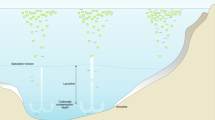Abstract
The dissolution of calcium carbonate in deep ocean water causes variation in calcium concentration (ΔCa) and alkalinity (ΔTA) in the ratio of one to two. The decomposition of organic matter generates nitric acid, phosphoric acid and sulfuric acid. A proton flux which is derived from this process also changes alkalinity. Using the variation in nitrate concentration (ΔNO3) as an index of the proton flux, the relationship betweenΔCa,ΔTA andΔNO3 is expressed asΔCa=0.5ΔTA+0.63ΔNO3 The values of ΔCa obtained from direct measurements in the North Pacific are in good agreement with the values estimated from this equation.
Similar content being viewed by others
References
Almgren, T., D. Dyrssen andM. Strandberg (1977): Computerized high-precision titrations of some major constituents of seawater on board the R. V.Dmitry Mendeleev. Deep-Sea Res.,24, 345–364.
Billings, G. K., O. P. Bricker, F. T. Mackenzie andA. L. Brooks (1969): Temporal variations of alkaline earth element/chlorinity ratios in the Sargasso Sea. Earth Planet. Sci. Lett.,6, 231.
Brewer, P. G., G. T. F. Wong, M. P. Bacon andD. W. Spencer (1975): An oceanic calcium problem? Earth Planet. Sci. Lett.,26, 81–87.
Culkin, F. andR. A. Cox (1966): Sodium, potassium, magnesium, calcium and strontium in sea water. Deep-Sea Res.,13, 789–804.
Chen, C.-T.A. (1978): Decomposition of calcium carbonate and organic carbon in the deep oceans. Science,201, 735–736.
Deuser, W. G. (1970): Carbon-13 in Black Sea waters and implications for the origin of hydrogen sulfide. Science,168, 1575–1577.
Edmond, J. M. (1970): High precision determination of titration alkalinity and total carbon dioxide content of sea water by potentiometric titration. Deep-Sea Res.,17, 737–750.
Horibe, Y., K. Endo andH. Tsubota (1974): Calcium in the South Pacific, and its correlation with carbonate alkalinity. Earth Planet. Sci. Lett.,23, 136–140.
Kanamori, S. andH. Ikegami (1980): Computer-processed potentiometric titration for the determination of calcium and magnesium in sea water. J. Oceanogr. Soc. Japan,36, 177–184.
Kester, D.R. andR.M. Pytkowicz (1967): Determination of the apparent dissociation constants of phosphoric acid in seawater. Limnol. Oceanogr.,12, 243–252.
Lyman, J. (1957): Buffer mechanism of sea water. Ph. D. Thesis, University of California, Los Angels, 196 pp.
Redfield, A. C., B. H. Ketchum andF. A. Richards (1963): The influence of organisms on the composition of sea water.In, The Sea, Vol. 2, ed. byM. N. Hill, Interscience, New York, pp. 26–77.
Shiller, A. M. andJ. M. Gieskes (1980): Processes affecting the oceanic distribution of dissolved calcium and alkalinity. J. Geophys. Res.,85, 2719–2727.
Tsunogai, S., H. Yamahata, S. Kudo andO. Saito (1973): Calcium in the Pacific Ocean. Deep-Sea Res.,20, 717–726.
Author information
Authors and Affiliations
Rights and permissions
About this article
Cite this article
Kanamori, S., Ikegami, H. Calcium-alkalinity relationship in the North Pacific. Journal of the Oceanographical Society of Japan 38, 57–62 (1982). https://doi.org/10.1007/BF02110291
Received:
Revised:
Accepted:
Issue Date:
DOI: https://doi.org/10.1007/BF02110291




